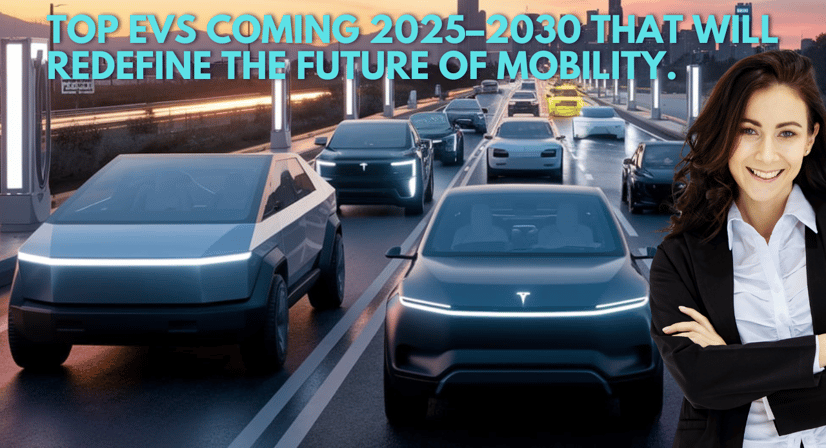The Electric Revolution: Top EVs Coming 2025–2030 That Will Redefine the Future of Mobility.
Explore the groundbreaking electric vehicles (EVs) set to redefine transportation from 2025 to 2030. From Tesla's bold Cybertruck to Toyota's solid-state battery innovations, discover how cutting-edge designs and technologies will shape a sustainable future of mobility.
BLOG POST
evnovatech.com
12/22/20244 min read


The Electric Revolution: Top EVs Coming 2025–2030 That Will Redefine the Future of Mobility.
The automotive industry is buzzing with excitement as electric vehicles (EVs) continue to make monumental strides toward reshaping the way we think about transportation. From futuristic designs to unmatched sustainability features, EVs promise to dominate the roads by 2030. If you’re curious about what the future holds for electric cars, this comprehensive guide will walk you through the upcoming game-changers and what makes them unique.
Introduction: The EV Boom—Why the Future is Electric
The transition to electric mobility isn’t just a trend; it’s a movement driven by environmental urgency and groundbreaking technological advancements. Governments worldwide are setting ambitious goals for phasing out internal combustion engines, with many aiming for fully electric fleets by 2035. As we gear up for the next wave of EV innovation, the 2025–2030 timeline is packed with exciting models that promise to push boundaries.
Whether you’re a seasoned EV enthusiast or a beginner exploring sustainable transportation, this guide will unveil the top EVs expected to hit the market and their cutting-edge features.
Why the Future of EVs Looks Bright
Electric vehicles are no longer niche products. The surge in adoption is driven by several factors:
Sustainability Goals: Governments are offering incentives and subsidies for EV adoption, aligning with global climate goals.
Battery Technology: Advances in battery efficiency and range are making EVs more practical for everyday use.
Charging Infrastructure: Rapid expansion of charging networks ensures EVs can compete with traditional vehicles.
Cost Parity: By 2030, experts predict EVs will cost the same—or even less—than their gasoline counterparts.
The EVs Set to Revolutionize Roads (2025–2030)
1. Tesla Cybertruck (2025)
Elon Musk’s brainchild, the Tesla Cybertruck, has already made headlines with its polarizing design and promises of extreme durability. Expected features include:
Range: Up to 500 miles.
Performance: 0 to 60 mph in less than 3 seconds.
Price: Starting at $50,000.
2. Apple Car (Expected by 2026)
Rumored for years, the Apple Car is expected to integrate cutting-edge autonomous driving technology and a seamless user experience. Highlights:
Autonomous Driving: Level 4 or higher.
Battery: Revolutionary lithium-iron-phosphate technology for extended life.
Ecosystem: Sync with Apple devices for a personalized experience.
3. Rivian R2 Series (2026)
Building on the success of its R1T and R1S, Rivian’s R2 series will target compact EV buyers:
Range: Estimated at 300 miles.
Affordability: Positioned as an entry-level EV.
Sustainability: 100% recycled materials for interiors.
4. Volkswagen Trinity Project (2026)
Volkswagen’s Trinity Project aims to redefine the EV market with a focus on high-tech features and sustainability:
Charging Speed: Add 150 miles in 10 minutes.
Autonomy: Advanced driver-assist systems.
Range: Over 400 miles.
5. Toyota Solid-State EV (2027)
Toyota plans to leapfrog competitors with its solid-state battery technology, offering:
Ultra-Fast Charging: Full charge in under 15 minutes.
Range: 600+ miles.
Durability: Batteries lasting over 500,000 miles.
6. Lucid Air Sapphire (2028)
Luxury meets performance with the Lucid Air Sapphire, targeting high-end EV buyers:
Performance: Over 1,200 horsepower.
Range: Nearly 500 miles.
Price: Premium pricing starting at $200,000.
The Role of Charging Infrastructure in EV Success
As the EV market expands, so does the need for accessible charging stations. By 2030:
Over 50% of new car sales are expected to be electric.
Global charging stations are projected to exceed 10 million, ensuring seamless travel.
Ultra-fast chargers will become standard, reducing charging times to under 20 minutes.
How EVs Are Revolutionizing Sustainability
EVs are not just about replacing gas engines—they’re about creating a sustainable ecosystem:
Zero Emissions: EVs produce no tailpipe emissions, drastically reducing air pollution.
Recycling Batteries: Companies like Redwood Materials are pioneering battery recycling to minimize waste.
Energy Integration: EVs can function as mobile power units, feeding energy back into the grid.
Challenges Ahead for the EV Industry
While the future looks promising, hurdles remain:
Battery Supply Chains: Dependence on rare earth materials like lithium and cobalt.
Cost of Infrastructure: Expanding charging networks requires significant investment.
Consumer Education: Overcoming misconceptions about range and performance.
FAQs About EVs Coming 2025–2030
1. Are EVs affordable for the average consumer?
Yes! By 2030, many EVs will achieve cost parity with traditional cars, thanks to declining battery prices and government incentives.
2. Will charging stations be widely available by 2030?
Absolutely. Governments and private companies are investing heavily in charging infrastructure, ensuring reliable access nationwide.
3. How do EVs contribute to sustainability?
EVs reduce carbon emissions, utilize recyclable materials, and support renewable energy integration, making them a cornerstone of sustainable transportation.
4. What are solid-state batteries, and why are they important?
Solid-state batteries use solid electrolytes, offering higher energy density, faster charging, and longer lifespans than traditional lithium-ion batteries.
5. Which EVs are the most anticipated by enthusiasts?
Models like the Tesla Cybertruck, Apple Car, and Toyota’s solid-state EV are generating significant excitement due to their innovative features.
Conclusion: The Road Ahead for Electric Vehicles
The EV market is poised for unprecedented growth, and the vehicles arriving between 2025 and 2030 promise to deliver innovation, performance, and sustainability. From Tesla’s bold designs to Toyota’s cutting-edge battery technology, these cars are not just vehicles—they’re a glimpse into the future of mobility.
As the world moves toward an electric future, there’s never been a better time to explore the possibilities of EVs. Whether you’re considering your first electric car or simply dreaming of what’s next, the journey promises to be as electrifying as the vehicles themselves.
